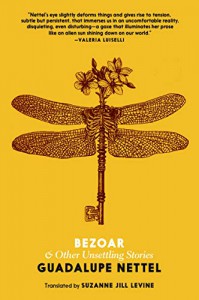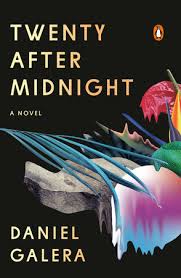This month’s selections of newly translated world literature seem to revolve around the unknown, be it to uphold or dispel it: a Mexican short story collection explores its protagonists’ dark psyches while providing no easy answers, a piece of Polish reportage rediscovers lost voices on nineteenth- and twentieth-century immigrant experience in America, and a Brazilian novel hilariously tackles a group of friends’ exploits in almost unchartered digital territory during the nineties.

Bezoar: And Other Unsettling Stories by Guadalupe Nettel, translated from the Spanish by Suzanne Jill Levine, Seven Stories Press, 2020
Review by Samuel Kahler, Communications Director
Unusual as they may be, the strange and wistful short fictions in Guadalupe Nettel’s Bezoar: And Other Unsettling Stories are not only clever in their portrayal of human desire and obsession; they are often wise as well. Nettel, an acclaimed Mexican author, was named as one of the Bogotá 39 and is a recipient of the largest Spanish-language short story collection prize, the Premio de Narrativa Breve Ribera del Duero. Bezoar is her second collection of stories, published in the original Spanish in 2008 and now translated into English by Suzanne Jill Levine.
Over the course of the book, Nettel and her characters have something fresh to reveal about their unique obsessions and secrets (the stories are told from the first-person perspective). But at just over one hundred pages, Bezoar is an all-too-brief journey through the grey areas and dark recesses of hidden passions, lusts, and compulsions.
Depending on one’s subjective definition, the narrators of Bezoar might be considered everyday people who, at face value, live quiet, unremarkable lives: a photographer in Paris, a man strolling through Tokyo’s botanical gardens, a teenager on a summer vacation, and—yes—a voyeur here, a stalker there, and one supermodel under psychiatric supervision. While memorable and idiosyncratic, these are not outsized characters with grand schemes; instead, they look inward and act in near-singular pursuit of resolving psychological issues. Fittingly, their stories are intimate chamber pieces that delight in the details of unfulfilled needs and wants, emotional attachments and detachments, and traces of personal insight that at times reflect a broader general truth about human dissatisfaction.
Readers of this collection will encounter Nettel’s impressive literary craftsmanship principally in two contrasting formats: on the one hand, a series of longer narratives that drive toward some kind of pathos, and on the other, a pair of multi-layered vignettes with enough mystery to merit repeated readings.
The first of the three longer, narrative works is “Ptosis,” which opens the collection by unfurling the scroll of a traumatic memory belonging to a Parisian man working as his father’s assistant in a photography studio. When a younger woman arrives to take pre-op portraits before undergoing a cosmetic surgical procedure, he becomes lovestruck, having never seen eyelids as beautiful as hers.
He explains the particular feelings caused by his encounter with a pictorial vividness befitting a photographer:
Her left eyelid was a fraction of an inch lower than her right. Both eyes had a dreamy look, but the left was abnormally sensual, and seemed heavy. When I saw her I was overcome by an unusual sensation, a sort of pleasant inferiority I experience in the presence of excessively beautiful women.
As is the norm for the narrators that populate Bezoar, the object of this man’s desire becomes an overwhelming obsession. Compared to those still to come, however, the peculiarity magnified here is middle of the pack. Others either occupy more ordinary territory or veer toward the more extreme end of the spectrum. Still, no matter how unusual each character’s yearnings may be, as Nettel charts their emotional dramas—doing so with particular success in the longer stories—the portrayals feel honest and without a hint of caricature.
In the longer works, such as “Ptosis,” the narrators embark on journeys toward a reckoning, often after some type of disaster befalls them. But with loss may also come hope, and these characters are depicted as capable of gaining something from the experience—renewed sympathy or self-knowledge. If this is what it means to write with humanity, then Nettel is endowed with a rare talent.
The mysterious quality of Bezoar, however, reaches its height in the collection’s pair of vignettes, whose narrators are not as traditional as the protagonists of the longer stories. They are less whole: the soft, strange voices of unseen souls.
In “Through Shades,” a woman observes her neighbor masturbating on his balcony while the lady he has brought back home with him waits in the living room, unaware of his private act. The voyeur’s account of her unsatisfied lust is enough to capture the reader’s curiosity, but it is the neighbor’s puzzling behavior that punctuates the story and underscores the sneaky complexity of Bezoar, which at times beckons us to go back a few lines and reassess. Is the neighbor’s problem one of shyness, or perhaps a fetish he’s ashamed by? Withholding such a curious detail leaves us wanting more—a literary tactic that serves to conjure an aura of mystique across the six stories.
In “Petals,” Nettel takes the concept of desire to low places—namely, the toilets of a certain neighborhood in Rome. The narrator traces the scent of a woman he’s nicknamed “La Flor” as he secretly follows her in and out of public restrooms, hoping to recapture his personal version of ecstasy. Trying to understand the man’s compulsions is a zero-sum game, and Nettel gives us no clue as to the proper or moral way to engage with this grotesque story; she elects, instead, to let its disturbing details creep and crawl.
“The best atmospheres are like states of mind, they can be sensed but not interpreted,” La Flor’s admirer muses—an observation that could apply just as well to Nettel’s collection on the whole.
While inviting us to return to its pages again and again for further clues, Bezoar offers no easy answers. With its nuanced insights, the collection often provides room for further investigation, resisting a sense of true conclusiveness. This could be disappointing in less masterful hands, but in Nettel’s, the medium becomes the message: these stories, like a mirror for human understanding, have rich depths that can be entered but never fully revealed.

Ellis Island: A People’s History by Małgorzata Szejnert, translated from the Polish by Sean Gasper Bye, Scribe, 2020
Review by Andrea Blatz, Blog Copyeditor
Twelve million immigrants passed through Ellis Island during the time it served as an immigration center from 1892 to 1954, yet most of their stories have been forgotten. In Ellis Island: A People’s History, Małgorzata Szejnert rediscovers some of these lost voices and brings to light a plethora of details about the people who spent time on the island. After realizing that there were no Polish texts about the immigration center, Szejnert decided to fill the gap with an innovative approach: she focused on primary documents—personal letters written by immigrants, unpublished testimonies from workers on the island, and archival photographs—to offer her readers a deeply personal view of the island and those that passed through, either as immigrants or employees. Indeed, this focus on the individual is a common feature in Szejnert’s works, through which she often gives a voice to those who have lost theirs. Sean Gasper Bye’s translation fills a gap in English-language works about Ellis Island as well. While many Americans know basic facts about the immigration hub, the book expands on this by making their stories relatable—by humanizing them.
The book is divided into seven parts, each recounting a period of the island’s history. It begins when it was home to the indigenous Lenni Lenape, who called it “Kioshk,” or “Seagull Island.” It continues with the ebb and flow of immigrants, as well as directors, doctors, social workers, and interpreters, all of whom left their mark there in some way until its closing in 1954. Szejnert then describes how it served as a rescue station after the attacks on the World Trade Center in 2001. Today, the building is a museum, and there is a memorial wall honoring those who passed through in the nineteenth and twentieth centuries.
Throughout the book, we learn about both immigrants and employees (some of whom were immigrants themselves). Many of the anecdotes included in the text are not only engaging on their own, but also compellingly deliver factual information. A particularly memorable one comes from the poem “The Mercy” by Philip Levine, in which a young girl eats a banana without peeling it; another is the unfortunate story of a young Polish girl who was duped into believing she would be getting married but was actually forced into prostitution. Fragments like these encourage compassion toward the immigrants and remind us of the humble beginnings of many Americans.
Another pertinent thread involves the different ways in which newcomers’ physical and mental health was checked. It may come as a shock to modern readers that, besides infectious diseases such as trachoma and cholera, alleged mental deficiencies were considered reason enough for deportation. So were a variety of other excuses, from communism to insanity. One of the island’s commissioners, “Commissioner Curran, maintaining his stony (some say wooden) countenance, declared immorality could be anything—from murder to a glass of beer,” and that it was up to the clerks to decide if hopeful newcomers should be turned away simply for looking “suspect.”
The book also follows employees’ lives on and off Ellis Island. I was especially interested in the stories of two of the interpreters, Frank Martoccia and Fiorella La Guardia. Both spoke six languages and were invaluable to the island’s operations. Szejnert emphasizes how important the role of interpreters was, as “they can be sensitive” to immigrants’ predicament and give them extra time to respond or convey composure in an otherwise stressful situation. After his beginnings as an interpreter, La Guardia became a lawyer working to protect immigrants’ rights, a congressman where he strongly opposed immigration quotas in 1924, and finally, the mayor of New York City.
Many issues depicted in the book are still relevant today. Szejnert establishes Ellis Island as a microcosm of the United States, as a melting pot of cultures and languages, but also as a place where the worst can happen. For instance, she describes how officials sometimes abused their power, extorting immigrants before they were approved to enter the United States. She also delves into racism in the form of “intelligence tests” conducted in Ellis Island as well as in national policies, such as the Chinese Exclusion Act of 1882 and immigration quotas enacted in 1921 and again in 1924, which greatly restricted the number of immigrants from poor Eastern European countries—especially Jewish immigrants.
The book has been published just in time for Women in Translation Month. In addition to filling a gap in American history, it gives attention to a female journalist in the male-dominated genre of Polish reportage. Anyone looking to learn more about the history of immigration in the United States will enjoy this intimate portrayal of American history.

Twenty After Midnight by Daniel Galera, translated from the Portuguese by Julia Sanches, Penguin, 2020
Review by Scarlett Castillo, English Social Media Manager
In a world doused with pandemic-induced anxiety and a fear of crumbling ecological disaster, it’s much too easy for us to fall prey to hopelessness and complacency. Still, despite this pervading apathy, Brazilian author Daniel Galera manages to shock and awe with his twistedly funny Twenty After Midnight. Translated from the Portuguese by Julia Sanches, Galera conjures a tale reminiscent of the days when the internet was only an archive of what life was—a nostalgic purview that provides just enough relief to distract from the machinations of the present.
Aurora, a struggling Ph.D. student, begins the book by describing her increasing disgust with life in her hometown of Porto Alegre, Brazil. Her failure to attain a doctorate in biology due to the vindictive power of a controlling professor, coupled with her father’s failing health, threatens to push her over the edge. Meanwhile, Emiliano, an aging journalist-turned-biographer gripped by the shadows of repressed feelings and regret, seeks answers to the riddles left behind by unfulfilling relationships. And Antero, a discontented and deeply self-conscious adman, refuses to accept that the life he has led doesn’t align with the vision he projected for himself when he was young.
In the late 1990s, the early days of e-zines, the three formed a group of movers and shakers, setting new literary boundaries in a barely explored digital world. Yet it’s only after the violent death of their enigmatic leader and friend, who hid in the recesses of social-media anonymity, that the group is forced to look back at the hedonistic, carefree life they’ve shared—one that vibrated with the energy that only a millennial experience steeped in nostalgic dread could provide. Mentions of the pornographic Two Girls, One Cup and references to Portishead and Formspring only draw the novel closer to the realities banished to the crevices of repressed early-2000s memories that suddenly rip readers through a vortex of bittersweet nostalgia to the present. Yet the anxiety and pessimism progressively voiced by the Brazilian trio in the novel is perhaps best expressed in the opening pages by Aurora.
It was probably then, in those few mystifying moments, that I was struck by the thought that these days were simply the gateway to a slow, and irreversible catastrophe, or that the force, the natural law or entity, that gave life to our expectations—and by “our,” I mean my expectations, those of my friends, my generation—was starting to die out.
From the beginning, a possible ‘ending’ is projected. And as readers, we are forced to agree with Aurora—or more precisely, the novel—not necessarily because we want to, but because we must, since it isn’t a question of agreeing with what is being said, but of seeing and accepting the eerie parallels in our own lives. Although the novel was initially published in 2016, Aurora’s hopeless sentiments seem to be ever more relevant in 2020, a year in which we need more distractions than ever from a pandemic, the rise of fascism, a global recession, and protests against racial oppression.
But thankfully, Twenty After Midnight pushes us forward—whether it’s through the novel or real life. Consider it the bittersweet pill we must swallow to carry on when handed a future that seems bleak. When a novel resonates with the apocalyptic anxieties of those growing up in the digital age, millennials—and anyone else who looks onward in fear of a failing world—may only push forward by laughing at the absurdity of it all.
*****
Read more on the Asymptote blog:

